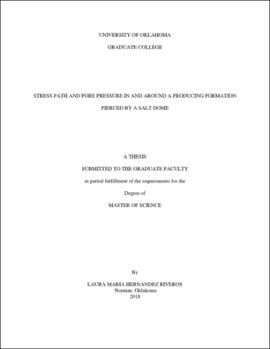| dc.description.abstract | The pore pressure decrease due to production from a reservoir causes changes in the total and effective stresses, leading to compaction and deformation of the reservoir and the surrounding rocks, which can translate into surface subsidence, casing deformation, sand production, and increment of seismic events in the compacted region. Reservoirs pierced by salt domes are characterized by complex stress regime close to the salt/sediment interface.
This thesis presents coupled flow and deformation numerical simulations to analyze the behavior of pore pressure and stress path along a reservoir pierced by a dome, as well as the influence of rock properties, reservoir dipping angles and salt creep on these trends after 13 years of production. The total stress path γ_j is defined as the ratio of the change in total stress (Δσ_j ) to the pore pressure change (Δp_f ), and the effective stress path 〖γ'〗_j is defined as the ratio of the effective stress changes (Δ'σ_j ) to the pore pressure change (Δp_f ). After 13 years of production, the total vertical stress in the reservoir decreased. The degree of reduction is a function of function of the well location (up to 1.42 MPa) and the 45° dipping angle (up to 1.7 MPa). The effective vertical stress increased as a function of the well location, where it reached a maximum value of 5.57 MPa and the dipping angle (up to 3.26 MPa. In the reservoir, the reduction of the total vertical stress at the salt/sediment interface was 1.46 MPa higher than the reduction in the area where the dipping angle is 0° “Flat area” (0.24 MPa). While the increment of the effective vertical stress at the salt/sediment interface was 0.99 MPa lower than the increment in the flat area (4.25 MPa). In addition, the total maximum horizontal stress decreased, also as a function of the well location (up to 2.55 MPa) and the dipping angle (up to 1.04 MPa). The effective maximum horizontal stress increased as a function of the well location (up to 4.52 MPa) and the dipping angle (up to 3.92 MPa). In the reservoir, the reduction of the total maximum horizontal stress at the salt/sediment interface was 1.04 MPa lower than the reduction in the flat area (2.08 MPa). While the increment of the effective maximum horizontal stress at the salt/sediment interface was 1.51 MPa higher than the increment in the area where the dipping angle is 0° (2.41 MPa). The total minimum horizontal stress decreased also as a function of the well location (up to 3 MPa) and the 45° dipping angle (up to 2.45 MPa). The effective minimum horizontal stress increased as a function of the well location (up to 3.92 MPa), while the increment at the salt/sediment interface (up to 2.52 MPa) and in the flat area (up to 2.49 MPa) was relatively the same. In the reservoir, the reduction of the total minimum horizontal stress at the salt/sediment interface was 0.45 MPa higher than the reduction in the flat area (2 MPa). The total vertical (γ_v ) and minimum horizontal (γ_h ) stress paths increase more at the salt/sediment interface than the flat region, while the effective vertical (〖γ'〗_v ) and minimum (〖γ'〗_h ) stress paths decreased less close to the dome compared to the well location and the flat area. The total maximum horizontal stress path (γ_H ) behaved different, it increased less at the salt/sediment interface than the flat region, whereas the effective stress path (〖γ'〗_H ) decreased more toward the salt dome. The spatial distribution of the stress path is controlled by the proximity to the salt, the dipping angle and the well location. Moreover, the horizontal stress reductions are more significant than the vertical stress reductions, with the highest reduction of the vertical and minimum horizontal stresses close to the salt dome where gravity drainage enhances the pore pressure drawdown near the salt/reservoir interface, compared to the changes in the flat zone. The depletion and the stress changes induce compaction in the reservoir.
The outcome from the sensitivity analysis shows that the reduction of the Young’s modulus and the steeper dip angles of the reservoir magnified the reduction of the total vertical stress up to 0.5 MPa, the maximum horizontal stress up to 0.2 MPa and the minimum horizontal stress up to 0.1 MPa, during production. However, the effective vertical stress increased 0.4 MPa less, the effective maximum horizontal stress increased 0.3 MPa less and the effective minimum horizontal stress increased 0.3 MPa less. Which is reflected as an increment of the total vertical and horizontal stress path values, that have a significant impact on compaction (the volumetric strain increased up to 2.97x〖10〗^(-4)). Lower reservoir pore compressibility and lower reservoir Biot’s coefficient results on lower vertical and horizontal stress paths along the producing formation, that resulted in 1.07x〖10〗^(-4) less volumetric strain of the reservoir. | en_US |
